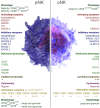NK cell dysfunction in antiphospholipid syndrome
- PMID: 40574865
- PMCID: PMC12197911
- DOI: 10.3389/fimmu.2025.1593705
NK cell dysfunction in antiphospholipid syndrome
Abstract
Antiphospholipid syndrome (APS) is a systemic autoimmune condition characterized by the persistent presence of antiphospholipid antibodies (aPL), and is commonly associated with thrombosis and pregnancy-related complications. To date, relatively little is known about the potential of NK cells in mediating the pathological effects of APS. While the role of NK cells in controlling immune responses and maintaining tissue homeostasis is relatively clear, the fact that they are also linked to various autoimmune conditions is now being highlighted. Given the impact of NK cells on immune regulation, vascular function, and pregnancy outcomes, the unifying message of a critical role for NK cells in APS emerges. As innate immune cells, NK cells might be activated in an antibody dependent manner and exert antibody-dependent cellular cytotoxicity (ADCC). In this process, NK cells recognize and bind to the Fc portion of antibodies that have attached to target cells. With their immunoregulatory properties in the uterus, NK cells play a crucial role in facilitating endometrial tissue remodeling, supporting vascular function, and contributing to placental formation, all of which are essential for a successful pregnancy. In APS, the presence of aPL may disrupt the delicate balance of NK cell-mediated immune regulation leading to alterations in cell activation, cytokine production, and cytotoxic functions. Given the multifactorial nature of NK cells in peripheral blood and uterus, the review provides insight into the potential underlying mechanisms through which NK cells may contribute to thrombosis and pregnancy complications in APS.
Keywords: NK cells; antiphospholipid antibodies; antiphospholipid syndrome; peripheral blood; placenta.
Copyright © 2025 Martirosyan, Kriegova and Manukyan.
Conflict of interest statement
The authors declare that the research was conducted in the absence of any commercial or financial relationships that could be construed as a potential conflict of interest.
Figures
References
Publication types
MeSH terms
Substances
LinkOut - more resources
Full Text Sources
Research Materials
Miscellaneous


